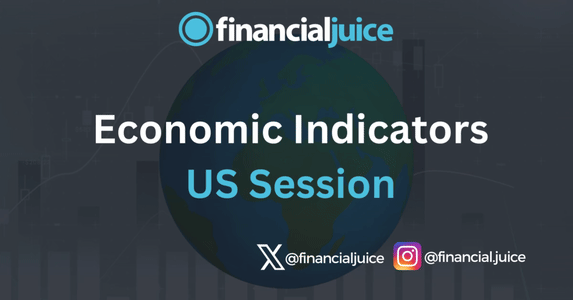
Week Ahead: Economic Indicators (US)
Hey, Traders!
For the April 22nd week, here is a list of all of the major economic indicators being released during the US Session, with a brief synopsis of what they represent and what to possibly expect from the markets in reaction.
Tuesday 23rd April
09:45 ET
US S&P Manufacturing & Services PMI April Prelim
The US S&P Manufacturing & Services Purchasing Managers’ Indices are composite economic indicators derived from surveys of purchasing managers in the manufacturing and services sectors.
It measures the prevailing direction of economic trends in these sectors by assessing factors such as new orders, production, employment, supplier deliveries, and inventories.
A PMI reading above 50 indicates expansion in economic activity, while a reading below 50 suggests contraction.
It provides insight into the health and direction of the US economy, helping analysts and policymakers make informed decisions.
What to Expect
If the PMIs come in higher than expected, generally, this could mean there is more demand for goods and services.
This could lead to higher consumer spending, which could be an upside risk to inflation and feed the ‘higher for longer’ rate narrative.
If realized, the dollar could see some strength, while US stocks could see some weakness.
If it comes in cooler than expected, the opposite could be expected.
10:00 ET
US New Home Sales for March
US New Home Sales is a key economic indicator that tracks the number of newly constructed homes sold during the month in the United States.
It provides insight into the strength of the housing market, consumer confidence, and overall economic activity.
Higher-than-expected new home sales suggest a robust housing market and can stimulate economic growth, while lower-than-expected sales may indicate weakness in the housing sector and broader economy.
What to Expect
This release is unlikely to move the markets; however, if US New Home Sales comes in higher than expected, this could be positive for US consumer sentiment.
Wednesday 24th April
08:30 ET
US Durable Goods March Prelim
The US Durable Goods Orders Preliminary Report provides early estimates of orders for long-lasting manufactured goods, such as machinery, appliances, and transportation equipment.
This data is an indicator of business investment and consumer confidence, as durable goods purchases typically require a significant capital outlay and reflect long-term economic expectations.
Higher-than-expected orders suggest potential economic growth and increased business activity, while lower-than-expected orders may indicate a slowdown in manufacturing and overall economic activity.
Policymakers and investors analyze this report to gauge the health of the manufacturing sector and make informed decisions about future economic trends.
What to Expect
If durable goods come in higher than expected, this could also mean consumers are spending more, possibly leading to an upside risk for inflation.
This could mean strength in the dollar and weakness in US stocks.
If it comes in cooler than expected, the opposite could be expected.
10:30 ET
US Weekly EIA Crude Oil Inventories
The US Weekly Energy Information Administration Crude Oil Inventories report provides data on the change in the number of barrels of crude oil held in inventory by commercial firms in the United States over the past week.
This data is monitored offers insights into the supply and demand dynamics of the oil market.
What to Expect
A larger-than-expected increase in inventories may indicate oversupply and downward pressure on oil prices, while a larger-than-expected decrease may suggest strong demand or production disruptions, potentially leading to upward pressure on prices.
Thursday 25th April
08:30 ET
US GDP Q1 Advanced
US Gross Domestic Product measures the total value of all goods and services produced within the United States.
It serves as a comprehensive gauge of the country’s economic performance and is published by the Bureau of Economic Analysis on a quarterly basis.
GDP includes consumer spending, business investments, government expenditures, and net exports (exports minus imports).
What to Expect
Changes in GDP growth rates reflect the overall health and direction of the US economy, influencing policy decisions and providing insights into economic trends.
In terms of the market’s potential reaction to this data point, this is tricky to gauge at the current stage of the economic cycle.
On one hand, a higher-than-expected GDP can be seen as an upside inflation risk, as it can indicate increased demand through increased consumer and government expenditures.
On the other hand, inflation is coming down towards the target despite resilient consumer demand, so a higher GDP number could also reinforce the chances for a soft landing, with inflation still returning to the target.
US Weekly Initial & Continued Jobless Claims
The US Weekly Initial Jobless Claims report provides the number of people who filed for unemployment benefits for the first time during the past week, serving as a measure of new layoffs.
This indicator is a key gauge of the labor market’s health and economic activity, with lower numbers suggesting fewer layoffs and a stronger job market.
Continued Jobless Claims, on the other hand, represent the number of people already receiving unemployment benefits.
This figure helps gauge the longer-term employment situation and provides insight into how easily displaced workers are finding new employment.
Both metrics are monitored by investors, policymakers, and economists because they offer real-time insights into labor market conditions and, by extension, the overall health of the economy.
What to Expect
Higher jobless claims indicate a higher unemployment rate.
The FOMC have noted that they see a higher unemployment rate to be in line with inflation’s descent back to the 2% target.
This means if Jobless Claims came in higher than expected, it could cause strength in US stocks and weakness in the dollar, as traders increase the chances of rate cuts this year.
Friday 26th April
08:30 ET
US PCE Price Index for March
The US Personal Consumption Expenditures Price Index is a measure of inflation that gauges the average change in prices consumers pay for goods and services over time.
Published by the Bureau of Economic Analysis, the PCE Price Index is considered a key indicator of inflationary trends in the economy.
It is based on personal consumption expenditures, reflecting how households allocate their spending across various categories. While similar to the Consumer Price Index (CPI), the PCE has some methodological differences, including the treatment of healthcare and the inclusion of a broader range of expenditures.
Most importantly, unlike CPI, it does not monitor a fixed basket of goods in every report and makes adjustments for the goods and services that are tracked based on consumer spending habits during the reporting period.
The ‘Core’ PCE Price Index is the Fed’s preferred gauge of inflation, stripping out volatile food and energy components.
What to Expect
If PCE comes in higher than expected, this would be likely to cause markets to reduce bets on interest rate cuts this year.
This repricing could cause weakness in US stocks, and strength in the Dollar and US Treasury yields.
If it comes in lower than expected, this could lead the Fed to have faith that inflation is still returning to target, increasing the chance of interest rate cuts this year.
This would cause strength in US stocks and weakness in the dollar.
US Consumer Spending for March
US consumer spending refers to the total amount of money spent by individuals and households on goods and services within the United States.
It encompasses expenditures on a wide range of items, including groceries, housing, transportation, healthcare, entertainment, and more. This metric is crucial for understanding the overall health of the economy because consumer spending typically represents a significant portion of the nation’s Gross Domestic Product (GDP).
When consumer spending is robust, it indicates that individuals have the financial means and confidence to make purchases, thereby stimulating economic growth.
Conversely, a decline in consumer spending can signal economic challenges or a slowdown.
What to Expect
If consumer spending comes in higher than expected, this could implicate upward pressures on inflation, which, in turn, would cause dollar strength and stock weakness.
Likewise, if it comes in cooler than expected, the inverse may be true.
10:00 ET
University of Michigan Sentiment & Inflation Expectations
The University of Michigan Consumer Sentiment Index measures the confidence of US consumers in the economy.
It is based on a survey that assesses consumers’ perceptions and expectations regarding their personal finances, business conditions, and overall economic prospects.
A higher sentiment index indicates increased confidence, which can positively impact consumer spending and economic activity, while a lower index may suggest reduced confidence and potential economic caution.
What to Expect
Consumer sentiment is watched by markets to assess consumer resilience in a high-interest-rate environment. Elevated sentiment may suggest strong demand, potentially leading to inflationary pressures, but it could also signal consumer resilience, reducing recession fears.
In this release, the market focus is on the 1 & 5-year inflation expectations accompanying the sentiment data.
Higher inflation expectations may delay Fed rate cuts, affecting US stocks negatively and strengthening the dollar.




